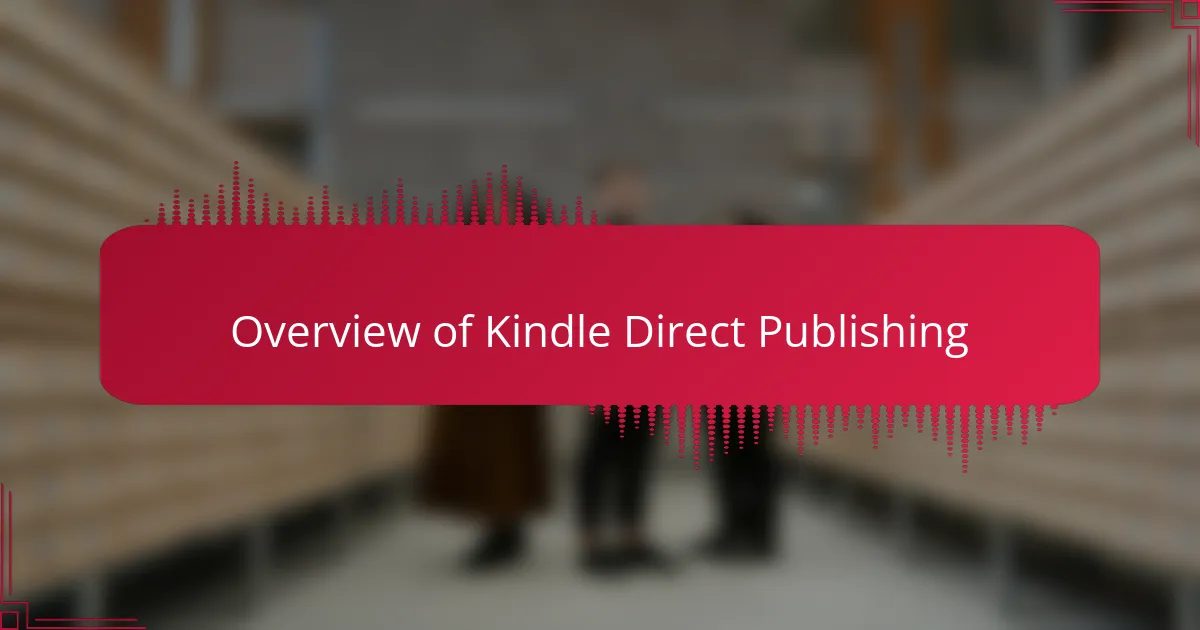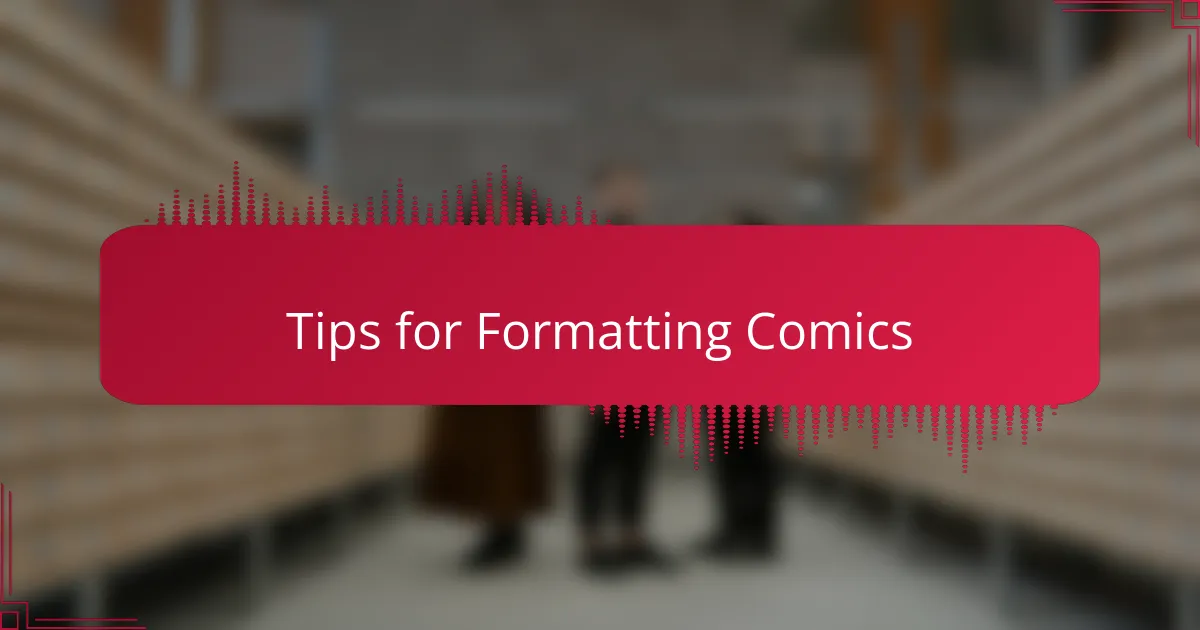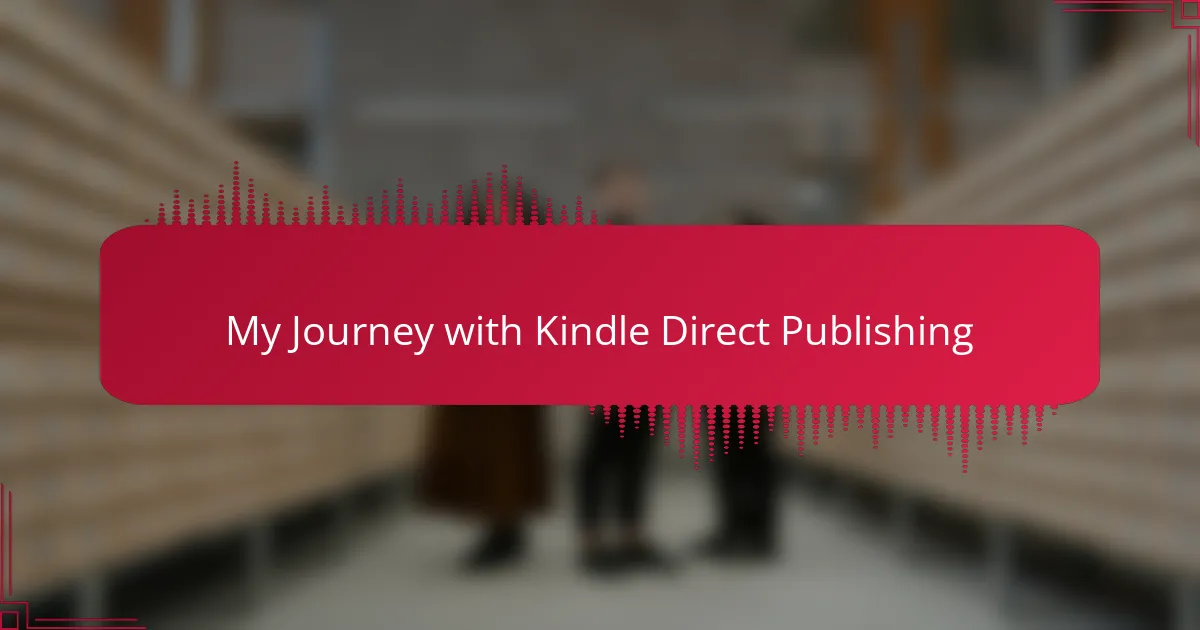Key takeaways
- Kindle Direct Publishing (KDP) offers authors creative control, higher royalties (up to 70%), and a quick route to market, enabling global reach and direct engagement with readers.
- The essential steps to publish a comic on KDP include formatting, creating a compelling cover, preparing the manuscript, uploading, setting pricing, and promoting the launch.
- Effective marketing strategies for comic authors involve leveraging social media, building email newsletters for loyal readership, and collaborating with other creators for increased visibility.
- Attention to detail in formatting, color management, and pagination significantly impacts the quality and professionalism of the comic, enhancing reader experience.

Overview of Kindle Direct Publishing
Kindle Direct Publishing (KDP) is a platform that allows authors to publish their works directly to Amazon. I vividly remember my excitement when I first discovered it—finally, I could share my comic stories with readers around the globe without going through traditional publishing hurdles. With KDP, the process is streamlined; you simply upload your manuscript, set your pricing, and voila, your work can be live in mere hours!
One of the standout features of KDP is the flexibility it offers in terms of formats. Whether you’re planning a comic book full of vibrant visuals or an illustrated guide, KDP supports various formats to meet your needs. I often ask myself, how empowering it is to have such control over formatting and publishing! It’s a game-changer for any author, especially for those like me, who want to maintain their artistic vision without compromise.
The royalties structure is also quite appealing. Authors can earn up to 70% royalties on sales, which, let me tell you, is a significant incentive! When I first calculated my potential earnings based on KDP’s model, it felt like the doorway to financial independence for my writing career. It’s not just about publishing; it’s about building your brand and achieving your goals in a way that feels achievable. Have you ever wondered how it would feel to see your work recognized and celebrated in such a vast marketplace? KDP has made that dream a reality for many authors, myself included.

Benefits of Kindle Direct Publishing
One of the standout benefits of Kindle Direct Publishing (KDP) is the creative control it offers authors. I remember the thrill of crafting my own comic book cover and deciding every little detail without waiting for approval from publishers. It’s empowering to see your vision come to life just the way you imagined it.
Additionally, the speed to market with KDP is impressive. The first time I hit ‘publish’, I was amazed at how quickly my work became available to readers globally. This instant gratification not only boosts confidence, but it’s also a powerful motivator to continue creating.
Here are some key benefits of Kindle Direct Publishing:
-
Higher Royalties: Authors typically earn up to 70% royalties on sales, compared to traditional publishing methods.
-
Global Reach: Your comic can be accessed by readers from all corners of the world.
-
Frequent Updates: Easily revise and update your work without going through lengthy publishing processes.
-
Direct Reader Engagement: Build a direct relationship with your audience through reviews and feedback.
-
Low Initial Costs: There’s minimal upfront investment, making it accessible for new authors.
Each of these aspects can significantly influence your journey as a creator and streamline the path to reaching your audience.

Steps to Publish a Comic Book
Deciding to publish my comic book through Kindle Direct Publishing was both thrilling and daunting. I still remember the late nights spent fine-tuning my artwork and script, all the while wondering if I was ready to share my creation with the world. The steps to publish were straightforward, but they required my full attention and creativity.
Here are the essential steps I followed to publish my comic book on KDP:
- Format Your Comic: Ensure your comic meets KDP’s formatting guidelines, including the right dimensions and file types.
- Create a Compelling Cover: Designing a visually striking cover was pivotal; I drew inspiration from other comics that resonated with me.
- Prepare Your Manuscript: I carefully assembled my pages into a single PDF, double-checking for any errors that could distract from the story.
- Upload and Set Metadata: Once I uploaded my comic, I filled in essential details like the book title, author name, and keywords to enhance discoverability.
- Set Your Pricing: I considered pricing carefully. I wanted to make it affordable for readers while ensuring I received fair compensation for my hard work.
- Launch and Promote: After hitting “Publish,” the rush of excitement was overwhelming. I shared my comic across social media and engaged with fellow comic enthusiasts to generate buzz.
Every step felt like a mini adventure, filled with anticipation and hope for what was to come.

Tips for Formatting Comics
When formatting your comic for Kindle Direct Publishing, I quickly learned that the technical details really matter. The first time I created a PDF for my comic, I struggled with dimensions. KDP recommends a size of 6” x 9” for comics, which can be tricky when you’re focused on your artistic layout. I found that using software like Adobe InDesign helped me maintain accuracy, ensuring my artwork wasn’t cut off and everything looked just right. Have you experienced that moment when a small detail can make or break your visual storytelling? I did, and it taught me the value of preparation.
Color management is another critical aspect that’s often overlooked. In my early comics, I used bright colors that looked fantastic on my screen but fell flat when printed or viewed on devices. Adjusting your color settings to CMYK for print and RGB for digital can make a world of difference. I remember feeling frustrated at first, but once I figured it out, my illustrations truly came to life.
Lastly, I can’t stress enough the significance of consistent pagination. Each page should flow seamlessly into the next, which demands careful attention to how panels interact with each other. After wrestling with a few layouts, I developed a rhythm that not only engaged readers but also conveyed emotion and pace effectively. This attention to detail gave my work a professional polish that I hadn’t anticipated. Have you thought about how pacing impacts the reader’s experience? For me, achieving that rhythm felt like a major victory in my journey as a comic creator.

Marketing Strategies for Comic Authors
When it comes to marketing my comic through Kindle Direct Publishing, I’ve found a few strategies that work wonders. Social media platforms like Instagram and Twitter have become vital for building a community around my work. I remember the excitement of sharing sneak peeks of my artwork and receiving instant feedback from readers–it’s incredibly rewarding and helps me grow as an artist.
Another effective approach I’ve embraced is creating an email newsletter. I can share my latest news, exclusive content, and even behind-the-scenes insights. This personal touch has helped me create a loyal audience who feels connected to my journey as a comic author.
Lastly, collaborating with fellow creators can expand your reach. I’ve teamed up with other comic authors for cross-promotions, which not only benefitted our visibility but also fostered a sense of camaraderie within the comic community. It’s a great way to learn from each other and share tips that benefit us all.
| Strategy | Description |
|---|---|
| Social Media Promotion | Engaging with readers through platforms like Instagram and Twitter to showcase artwork and gather feedback. |
| Email Newsletters | Sending updates, exclusive content, and personal insights to build a loyal readership. |
| Collaborations | Working with other comic creators for cross-promotion and knowledge sharing. |

My Journey with Kindle Direct Publishing
Publishing my first comic through Kindle Direct Publishing was a journey filled with mixed emotions. I remember nervously uploading my masterpiece and eagerly checking my dashboard, wondering if I had made any mistakes. The first sale notification was exhilarating—it felt as if my dreams had taken flight. How could something so simple as hitting “publish” lead to such joy? It was a moment I’ll never forget.
As I navigated through the various KDP tools, I quickly realized that every detail mattered. I became obsessed with perfecting my comic’s formatting and cover design because I knew these were the first things potential readers would see. I still laugh when I think about the countless late nights I spent tweaking my cover until it matched the vision I had in my mind. There’s something thrilling about taking complete control over how your work is presented. Have you ever felt that same rush when bringing your vision to life?
Looking back, each step was not just a process; it was a transformation. I shifted from being an aspiring creator to a published author. Each sale and every reader review reminded me that my work mattered and connected with others. This evolution fueled my passion, driving me to create even more. It’s amazing how a platform like KDP can change not just your career, but also your perspective on what’s possible for your creative journey.
